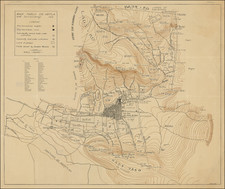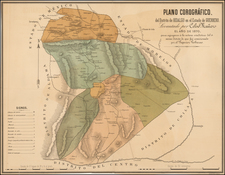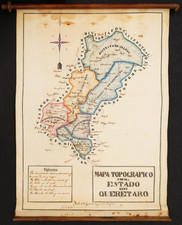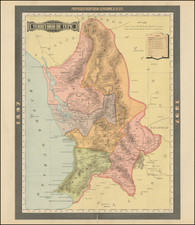Including Fine Images of the Utopian Colony of Topolobampo
Rare map of the state of Sinaloa in Mexico, with a large portrait of Mexico's President, Porfirio Diaz.
The map includes a large map of Sinaloa, surrounded by smaller maps of Mazatlan, the route from Mazatlan to Durango, maps of the ports of Topolobampo and Altata, birdseye views of Mazatlan and Topolobampo and views of the Plaza de Armas at Culiacan and the Palacio de Gobierno, along with smaller maps showing ethnographic and industrial information.
Mariano Martínez de Castro (1841 - 1901), was a surveying engineer who held various public positions, including mayor of the Culiacán prefecture, senator of the Republic and governor of the state of Sinaloa. Among his achievements are obtaining a concession for a railroad between the port of Altata and Durango and establishing a telegraphic network that linked Tepic, Mazatlán, Culiacán and Álamos. He is considered one of the main figures in the history of Sinaloa in the XIX century.
Topolobampo
The development at Topolobampo is shown with great promise, where Albert Kinsey Owen’s utopian colony is shown.
American Albert Kimsey Owen and others established a socialist utopian colony in Topolobampo in 1886. The Topolobampo cooperative colony was founded at Topolobampo Bay near Los Mochis, Sinaloa, Mexico. The colony was established and governed under a set of idealistic bylaws, predicated on socialistic reforms.
The driving force behind the colonization effort was Albert Kimsey Owen (1847-1916). Owen began working as a surveyor and civil engineer for the Denver and Rio Grande Railroad. In the course of his work, Owen was sent to Mexico's west coast to look for promising harbor sites, and there he had his first look at Topolobampo Bay.
From 1873 through 1880 Owen worked to implement his dream of a port at Topolobampo Bay. He quickly organized an American syndicate and with a small contingent, embarked on a journey in late August of 1880, bound for Vera Cruz, Mexico. The ship was lost in a hurricane off the coast of Florida with only four survivors. The accident set back Owen five years.
Owen’s original plan was to build a railroad from Texas to Topolobampo (the Texas, Topolobampo, and Pacific Railroad). However, Owen’s family background and experiences living at another utopian colony in Indiana led to him being a staunch and idealistic socialist in addition to being a railroad promoter and engineer. His plan included a cooperative colony in Sinaloa where the reorganization of labor and distribution followed the principles laid out in his essay "Integral Co-Operation."
Out of this plan came the Credit Foncier Company of Sinaola. The Credit Foncier Company issued stock, script and credits in return for labor which benefited the colony. It was also the agency used to acquire and hold land for Owen and the colony. Plans for the colony included a grand city called Pacific City, based on Owen’s utopian ideal, as well as several agricultural colonies along the Fuerte River to the north of Topolobampo Bay. The railroad and the colony were to be mutually beneficial. The first settlers arrived in 1886. Two and a half years later, in April 1889, the first large group of colonists—300-strong—set sail from New York, arriving in Sinaloa in July, only to find a deserted beach and no Owen. Owen had returned to the USA but finally arrived the following year with another 30 colonists. During 1891, 70 more settlers arrived. They founded several additional settlements including Vegatown (Estación Vega), La Logia, El Público and El Platt. They also dug an irrigation canal, 7 kilometers long, to divert water from the Fuerte River across their lands. Despite their heroic efforts, the farming project was eventually abandoned.
That utopian group published a newsletter in English, The Credit Foncier of Sinaloa in Topolobampo. The masthead says "Collective ownership and management for public utilities and conveniences - the community responsible for the health, usefulness, individuality and security of each. - Albert K. Owen." Two pages of one edition (vol. 4, no. 24, September 1, 1889, whole no. 161), has been preserved at Western Reserve Historical Society in Cleveland, Ohio, pasted into a Wallace Cathcart scrapbook on Shakers. Those two pages include an article on the Tyringham, Massachusetts Shakers and correspondence from several prospective members. Evidently the fledgling group hoped to use the reminiscences of Julia Johnson, a former Shaker, to market the concept of a communal society to prospective members.
Rarity
The map is very rare on the market. This is the second example we have seen in the past 30 years.















![[ Baja California / Mexico ] Carta particolare della parte ocidentale della nuova Spagnia, e del la California . . . D'America Carta XXXI](https://storage.googleapis.com/raremaps/img/small/101394.jpg)
![[Yucatan Postal Map] Carta Postal de la Republica Mexicana Estado de Yucatan . . . 1934](https://storage.googleapis.com/raremaps/img/small/55195.jpg)